#Ram Intake System
Explore tagged Tumblr posts
Text
Banks 42790-PC Monster-Ram Intake System 4" | 07.5-18 Dodge Ram
Upgrade your 07.5-18 Dodge Ram 2500/3500 6.7L Cummins with red Banks 42790-PC Monster-Ram Intake System 4 inch comes with Fuel Line and Hump Hose. Shop Now!

3 notes
·
View notes
Text
Battle Tanks Cease Firing

STAR WARS EPISODE I: The Phantom Menace 01:48:28
#Star Wars#Episode I#The Phantom Menace#Naboo#Naboo system#Battle of Naboo#Multi-Troop Transport#MTT#primary laser cannon#AAT#Armored Assault Tank Mk I#power converter#Shaak Ridge#nose ram#front hatch#short-range blaster#air cooling intake#shell launcher armor plate#energy shell launch tube
0 notes
Text
An intercooler, also known as a charge air cooler, is an automotive component that cools the hot, compressed air from a turbocharger or supercharger before it enters the engine for improved performance and efficiency.
#Mishimoto Intercooler Kit for 5.9L Cummins 24V#Mishimoto Intercooler for Cummins 24V#BD Diesel Manual Controlled Positive Air Shut-Off#Banks Power Ram-Air Intake System#Monster-Ram Intake System
0 notes
Text

From top:
1970 Oldsmobile 442 W30. The "455 W30" refers to engine & performance package available for 1970 Oldsmobile 442. W30 package included a 455 cubic inch V8 engine producing 370 horsepower, forced-air induction, a special air cleaner, an aluminum intake manifold, and other performance enhancements. It was the ultimate high-performance Oldsmobile of its time, and the 1970 model was even selected to pace the Indianapolis 500. Only 3,100 Oldsmobile 442s were assembled with the W30 option in 1970.
1970 Chevrolet Chevelle SS 454 LS6. Powered by LS6 version of 454 Turbo-Jet engine, producing 450 horsepower & 500 lb-ft of torque. Acceleration from 0 to 60 mph in around 5.5 seconds and complete a quarter-mile in the low 13-second range. The 1970 Chevelle SS 454 LS6 is often referred to as the "King of the Muscle Cars" due to its powerful engine and limited production numbers. Only 4,475 Chevelles produced with the L56 engine option making it a highly sought after. The 1970 Chevelle SS 454 LS6 Convertible is especially rare, with estimates suggesting only 20 to 25 still exist.
1970 Buick GS 455 Stage 1. "Stage 1" denotes a performance upgrade package & this version produced 360 horsepower & 510 lb-ft of torque. Motor Trend recorded 13.38-second quarter-mile time at 105.5 mph, making it the quickest car they tested in 1970. In 1970, Buick produced 10,148 GS 455s (including GSXs), with only 2,697 equipped with Stage 1 package. rare and valuable muscle car. Some sources suggest the horsepower was underrated to manage insurance cost ( but you didn’t hear this from us ; )
1970 Pontiac 400 GTO Ram Air IV. Most powerful engine available for the GTO. 400 cubic inch displacement of engine & Ram Air IV high-performance induction system, rated at 370 horsepower. A 1970 GTO Judge Ram Air IV sold for over $1.1 million, highlighting the model's rarity & desirability making this Ram Air IV, world’s most expensive GTO. Stricter emissions regulations began to impact engine performance in the following years & its performance charisma dwindled.
#70s icons#1970s history#1970s style#oldsmobile cutlass#chevelle ss#Buick#buick gs#auto show#muscle car#pontiac gto#70s nostalgia#gm group#very rare
182 notes
·
View notes
Text




American Motors Javelin SST "Go Package," 1970. The 1970 Javelin was a one-year-only design featuring a new front-end design with a broad "twin-venturi" front grille incorporating the headlamps. The bonnet had dual air intakes and a functional Ram Air system with the Go-Package which came with either a 360 or 390ci 4-barrel V8 engines. This was the final year for the first generation Javelin
#American Motors Javelin#AMC Javelin#American Motors Javelin SST#Go Package#1970#first generation#dead brands#AMC Javelin SST “Go Package”#pillarless hardtop
182 notes
·
View notes
Text
1962 Plymouth Savoy Max Wedge: Unleashing the Power of Muscle
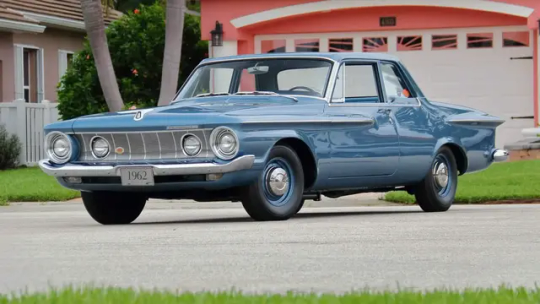
1962 Plymouth Savoy Max Wedge
In 1962, a new era of muscle cars emerged, radiating brilliance and power. Chrysler led the way with their groundbreaking Max Wedge lineup, introducing the world to the fusion of unitized-body construction and the high-performance ram-tuned dual-carbureted 413 CI engine. Among these legends was the Plymouth Savoy Max Wedge, a remarkable vehicle that holds a significant place in automotive history.
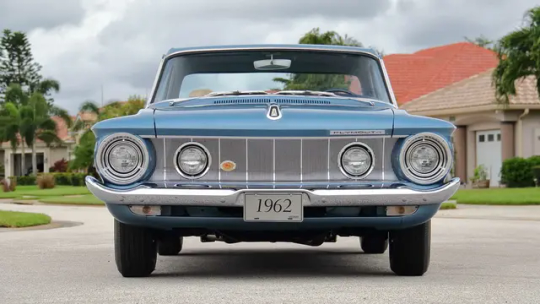
1962 Plymouth Savoy Max Wedge
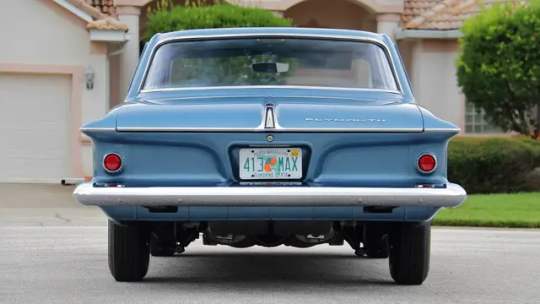
1962 Plymouth Savoy Max Wedge
The First Super Stock Max Wedge with Manual Transmission According to the esteemed Chrysler Registry and the meticulous documentation by Darrell Davis, this specific Plymouth Savoy Max Wedge holds a groundbreaking distinction—it was the first Super Stock model equipped with a manual transmission. The car’s odometer displays a mere 6,593 miles and has undergone a meticulous restoration process to return it to its original specifications. Notably, the engine has been upgraded, boasting a dyno-proven power output exceeding 500 HP.
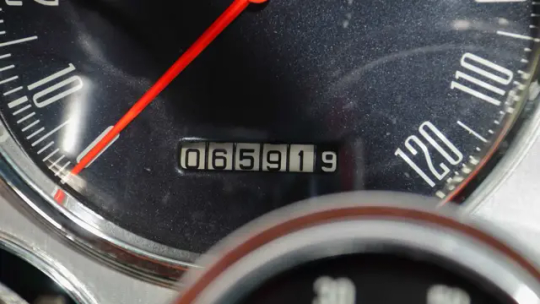
1962 Plymouth Savoy Max Wedge
Unleashing the Power of the 413 CI V-8 Engine The 1962 Plymouth Savoy Max Wedge was powered by the formidable 413 CI V-8 engine. This was the first iteration of Chrysler’s renowned ram induction system, featuring a cross-ram intake manifold meticulously designed to optimize engine efficiency. The engine’s performance was further enhanced by the utilization of cast-iron header-style manifolds, which were rarely preserved but featured in this exceptional vehicle. Dale Reed of California refreshed the engine around 300 miles ago, ensuring its optimal performance. The correct Carter AFB carburetors reside beneath dual black air cleaners, accentuated by carefully placed decals.
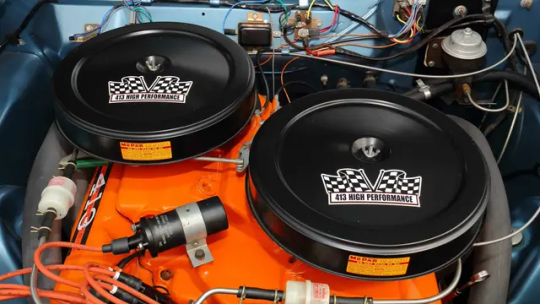
1962 Plymouth Savoy Max Wedge
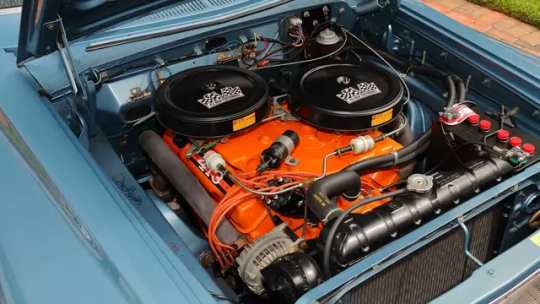
1962 Plymouth Savoy Max Wedge
A Unique Manual Transmission Experience One of the distinctive aspects of this Plymouth Savoy Max Wedge is its manual transmission. Unlike its automatic counterparts, this car delivers a unique driving experience through its floor-mounted shifter, allowing the driver to truly feel the power at their fingertips. Paired with a full aftermarket exhaust equipped with cutouts and the robust 8 ¾ Chrysler differential, this Max Wedge offers an exhilarating ride for those who crave the thrill of the open road.
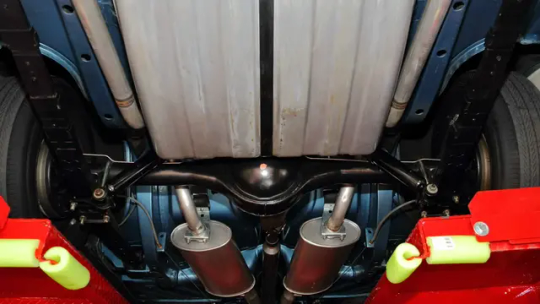
1962 Plymouth Savoy Max Wedge
Captivating Style and Authenticity The exterior of this Plymouth Savoy Max Wedge embodies the spirit of the era. Finished in captivating light blue paint, it exudes a timeless charm. The interior features a complementary blue cloth-and-vinyl combination, while the white-and-blue two-tone trim adds an elegant touch. The front and rear bench seats provide comfort, and the radio delete plate pays homage to the car’s performance-focused nature. Notably, it features a knee-knocker S-W column-mounted tachometer and a beautifully presented trio of rubber pedals. The car’s attention to detail is evident throughout, with the inclusion of circa-1962 chrome fonts, single-lens tail lamps, and OEM steel wheels adorned with poverty-type hubcaps.
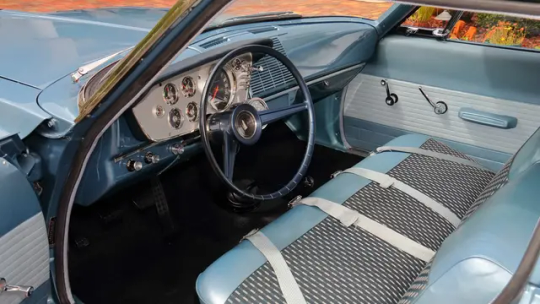
1962 Plymouth Savoy Max Wedge
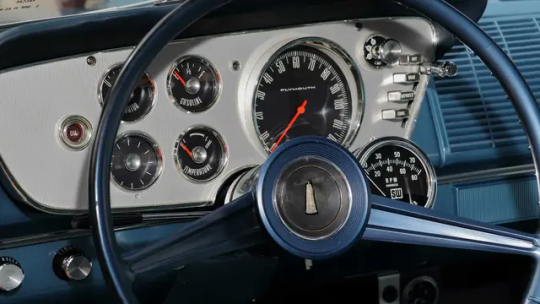
1962 Plymouth Savoy Max Wedge
Provenance and Documentation Accompanying this Plymouth Savoy Max Wedge is a wealth of provenance and documentation that adds to its allure. It includes the original OEM IBM punch card and build sheet, which serve as a testament to its authenticity. Additionally, the window sticker provides insight into its original specifications, while the dyno sheet confirms its impressive horsepower rating. Vintage photos capture the car’s early years when it was part of a famous drag car collection, showcasing its illustrious past.

1962 Plymouth Savoy Max Wedge

1962 Plymouth Savoy Max Wedge
Conclusion The 1962 Plymouth Savoy Max Wedge stands as a testament to the golden age of muscle cars. With its groundbreaking manual transmission configuration, powerful 413 CI V-8 engine, and captivating style, it represents the pinnacle of Mopar’s storied performance heritage. Meticulously restored to its original glory, this Max Wedge allows enthusiasts to experience a bygone era’s raw power and timeless charm.
FAQs: How many miles does the 1962 Plymouth Savoy Max Wedge have? The odometer of the 1962 Plymouth Savoy Max Wedge reads 6,593 miles. Who documented the Chrysler Registry for this particular car? The meticulous documentation of the Chrysler Registry for this car was done by Darrell Davis. Has the engine of the 1962 Plymouth Savoy Max Wedge been upgraded? Yes, the engine of this Plymouth Savoy Max Wedge has been upgraded to a dyno-proven 500-plus HP. What is the significance of the 413 CI V-8 engine in this car? The 413 CI V-8 engine in this car was the first to receive Chrysler’s shortened version of ram induction, known as the cross-ram intake. It maximizes engine efficiency and pairs it with rarely preserved cast-iron header-style manifolds. What documentation and provenance come with this Plymouth Savoy Max Wedge? This Plymouth Savoy Max Wedge comes with various documentation, including the OEM IBM punch card, build sheet, window sticker, dyno sheet confirming horsepower rating, and vintage photos of its early years as part of a famous drag car collection.
#Plymouth Savoy Max Wedge#Plymouth Savoy#plymouth#Max Wedge#car#cars#muscle car#american muscle#mopar#moparperformance#moparnation#moparworld
95 notes
·
View notes
Text
Toyota Supra Upgrades: A Guide by Toyota of N Charlotte
Are you looking to upgrade your Supra?
This sports car is already iconic, but there are lots of ways you can customize your ride and make it your own! Our N Charlotte auto care experts are here to talk about Toyota Supra exhaust, turbos, air intake, and more!
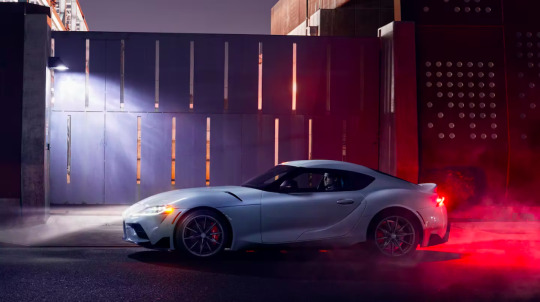
Selecting Your Toyota Supra Exhaust
Which Toyota Supra exhaust you choose should depend on why you want one. Your new Toyota Supra exhaust will make the vehicle louder, more powerful, and it can increase airflow or improve fuel efficiency. Here are some things to look out for when choosing:
When it comes to material, you want to stick with stainless steel or aluminized steel. Stainless steel is resistant to high temperatures, corrosion, and rust, and aluminized steel is just a lighter, cheaper option.
Make sure the piping diameter is not too narrow or too wide. This will affect gas flow and performance.
Ensure that you have the correct model for your car and get the installation done by a mechanic you trust.
Selecting Your Toyota Supra Turbo
Looking to increase the power and torque of your car? A new Toyota Supra turbo may be the perfect upgrade for you. Here are some tips from our N Charlotte Toyota team on choosing your new Toyota Supra Turbo.
Decide what horsepower range you’re aiming for before purchasing a Toyota Supra turbo. Also, ensure your car has the traction to handle the turbo you choose.
Think about the thermodynamics involved with increasing power. You don’t want a turbo that will push the temperature up too high when maximizing forced induction.
Make sure the compressor and turbo you choose can push a lot of air into the engine’s cylinders.
Selecting Your Toyota Supra Air Intake
Similar to Toyota Supra turbos, the Toyota Supra air intake system uses air to create more power in the engine. Below are some things to think about when choosing a new N Charlotte Toyota Supra air intake:
Cold air intakes are better for performance because cold air is more rich in oxygen, which enhances combustion.
There are two types of styles with cold Toyota Supra air intakes (short ram and true).
The short ram requires less fabrication work since you can access the air filter more easily.
The true cold pushes the air as far forward as possible but might require more “plumbing” and fabrication.
You want to choose a Toyota Supra air intake that matches your car model and year. This will ensure easy installation.
You want to go for heat resistant materials. You want it to stay cold in your engine, but also not hot in your air intake system.
Using straight hoses in your Toyota Supra air intake system is more efficient for airflow than curved hoses.
You want to select a weather and water resistant system. Any water that gets inside the system can cause a huge engine failure.
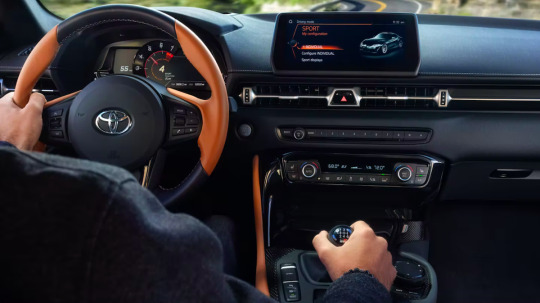
Want to Learn More About Toyota Supra Turbos and Upgrades?
Toyota of N Charlotte is here with more info on upgrading your Toyota Supra. Stop by 13429 Statesville Road and our auto service techs will make sure you pick out the right Toyota Supra turbo for your ride! Just take exit 23 off I-77 in Huntersville.
2 notes
·
View notes
Text
What Are The Best Performance Upgrades For Dodge RAM 1500?

The Dodge RAM 1500 is the vehicle of choice for many when it comes to off-roading… From 3.0- liter EcoDiesel V-6 engine to 5.7- liter HEMI V-8 engine; Dodge RAM 1500 has a robust engine line up. And, guess what??? With a few simple performance upgrades, you can unlock its real potential that the manufacturer had left on the table.
Interested in learning more about these performance upgrades??? Well, read this blog post all the way through…
Improve Your Dodge RAM 1500 Performance with These Upgrades
Before we begin… let’s us clarify a few things. This article has a generalized explanation of Dodge RAM 1500 performance upgrades. No particular Dodge RAM engine type is being discussed here. Therefore, if you need specific information on 5.7L HEMI V-8 engine performance upgrades, or information about other engine types for that matter, contact a qualified expert.
It's time to move on to our main topic now that the disclaimer has been concluded.
Upgrade #1- Cold air intake
Installing a cold air intake system is one upgrade you can make to improve the performance of your Dodge RAM 1500. Cold air intake, as is evident from the name as well, is a system designed to feed the engine with cold dense air. More air promotes fuel burning inside the combustion chamber, which produces more power.
But, before you install a cold air intake system, you should understand about its benefits and drawbacks, such as how it will affect your vehicle's fuel consumption, torque output, etc…
Upgrade #2- Performance tuner chip
Plugging in a performance tuner chip to your Dodge RAM 1500 is another option to improve its performance. For those who don’t know, the performance tuner chip is a computer unit that can make a few tweaks to your RAM's engine control module, or ECM, to improve engine performance.
Plus, it has been found that the use of performance tuner chip can significantly improve a vehicle’s gas mileage. But, but, but… using such technologies to boost engine performance has several downsides that you should be aware of.
Upgrade #3- Throttle body spacer
Adding a throttle body spacer to your Dodge RAM 1500 engine is one more change you can make to bring out its full potential. The RAM's throttle body and upper intake manifold is where you must put them. The part will significantly enhance your RAM’s air intake capacity. It will funnel more air into the combustion chamber of the engine.
And, as we just explained in the above paragraph, more air would result in effective fuel combustion and increased torque production. But, again… do some research before installing it.
Upgrade #4- Exhaust modification
The exhaust system can also be upgraded for greater engine performance. The combustion gases are essentially vented to the outside air by the exhaust system. The exhaust system installed on your Dodge Ram has limits on how fast it can discharge engine emissions. You may improve the exhaust fume flow rate of your Dodge RAM by upgrading the exhaust pipes.
Increased exhaust flow can dramatically improve your vehicle's torque production. But… you should only have qualified technicians modify the exhaust system on your Dodge RAM.
Upgrade #5- Cooling system upgradation
The torque output of your Dodge RAM will not be directly affected by cooling system upgrades, but the durability of its engine most certainly will be. The cooling system essentially keeps the engine temperature within the permissible range; thereby preventing it from overheating.
Off-road vehicles' engines, like the one in the Dodge RAM 1500, occasionally have to work harder and produce a lot of excess heat. You'll need a performance water pump, a multi-core radiator, and a heavy-duty electric fan in these circumstances to dissipate extra engine heat.
Key Takeaways
These performance upgrades can help your Dodge RAM 1500 unlock its full potential and transform it into a real off-roader. There are numerous other things that you can also do to get the most out of your Dodge RAM 1500.
In any case, before you start upgrading your vehicle, you must do some research on the pros and cons of using those technologies to unleash the power that you are not supposed to. That’s all for today’s blog post. We hope this had added value to your knowledge.
3 notes
·
View notes
Text
Taking a Look at Upgrades Like Toyota Supra Turbos
Looking for an upgrade? The Toyota Supra is a fantastic vehicle, which you probably know already if you own one. If you’re looking to take your car to the next level, our Orlando Toyota team is here with a guide to Toyota Supra turbos, upgrades, and more!
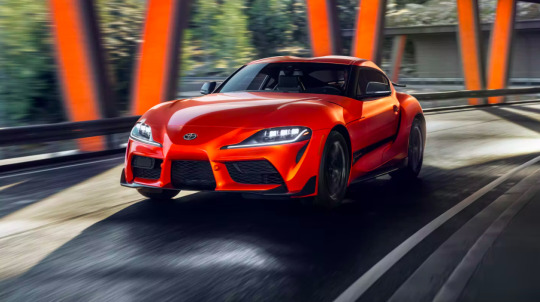
Toyota Supra Turbos, Exhausts, and Air Intakes: Let’s Get Into It!
Let’s talk about the performance upgrades available for your Orlando Toyota Supra. Whether you’re looking for a new exhaust or turbo, we’ve got you covered.
Upgrading Your Toyota Supra Exhaust
So, how do you choose a new Toyota Supra exhaust? If you’re looking to improve airflow to the engine, make your car louder, and improve fuel efficiency then an upgraded Toyota Supra exhaust is a great option for you. Here are some factors to consider:
Material: You want to choose a quality material for your exhaust. Stainless steel is rust resistant and can withstand high temperatures/corrosion. If you’re looking for a cheaper and lightweight option, aluminized steel is a great alternative (just not quite as durable).
Piping diameter: This is important because if the piping is too narrow or wide it can affect performance and how exhaust gasses flow.
Installation: You should check that the Toyota Supra exhaust you choose doesn’t involve welding and that it fits the model you own. You can always talk to one of our Toyota of Orlando auto technicians if you’re not sure.
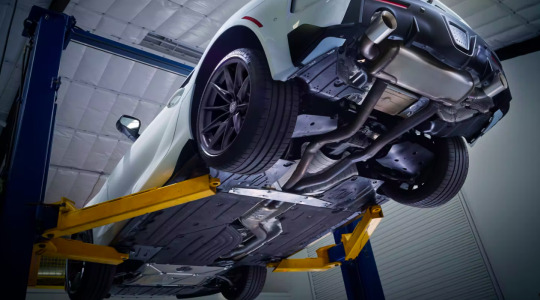
Upgrading Your Toyota Supra Turbo
Here are some things our Toyota of Orlando team suggests you think about when choosing a Toyota Supra turbo:
Decide what horsepower range you want. You don’t always need the biggest turbo option available - consider your specific vehicle and what your traction/engine can handle.
Consider the thermodynamics involved. The last thing you want is to increase temperatures to the point of damaging your vehicle or engine.
Be careful when choosing your compressor. When choosing a Toyota Supra turbo, you’ll need to ensure the compressor is efficient when pushing air into the engine’s cylinders.
Upgrading Your Toyota Supra Air Intake
The Toyota Supra air intake system basically uses air to create more power. By combining airflow tubes and an air filter, the Toyota Supra air intake system will be able to push more oxygen into the engine. Here’s what you should think about what you choose your Toyota Supra air intake system:
2 types of cold air intake styles
Short ram makes accessing the air filter easier
True cold air intake needs more fabrication and plumbing
Cold air intake is preferable for the Supra because cold air enhances combustion
Choose a Toyota Supra air intake that works for your specific model and year
You want to go for heat-resistant materials to ensure air stays cold on its way to the engine
Straight hoses are more efficient than curved hoses
Ensure your Toyota Supra air intake system is weather resistant and protected from water (water in the system can lead to engine failure)
Get info on Toyota sports car exhaust, turbo, and more at Toyota of Orlando
Ready to upgrade your Toyota Supra? Call or visit Toyota of Orlando today. We’re conveniently located just off I-4 near the Millenia Mall at 3575 Vineland Road, and you can reach us seven days a week at (407) 298-0001.
2 notes
·
View notes
Text
Yamaha Celebrates 25th Anniversary of the Revolutionary R1


Yamaha Motor Europe is proud to celebrate the 25th anniversary of the ground-breaking R1 with dedicated activities planned at the Yamaha Racing Experience (YRE). This year the YRE will be held at the legendary Mugello Circuit in Italy on the 21st and 22nd of July and will bring together some of Yamaha's biggest stars and enthusiasts to honour the remarkable legacy of the iconic machine. Since its launch, the Yamaha R1 has redefined standards of performance and innovation in the industry. Its 25-year journey of evolution is a testament to Yamaha's dedication to engineering excellence, which cemented the R1 as an icon of speed, power, and cutting-edge technology that revolutionised the sports bike market. Making its grand entrance in 1998, at the core of the R1 was an innovative, compact, and lightweight 998cc, liquid-cooled, 20-valve, double overhead camshaft, four-cylinder engine which featured a five-valve-per-cylinder head with redesigned valve sizes to boost torque and improved porting. However, the real game-changer came from Project Leader Kunihiko Miwa's ingenious decision to create the world's first vertically stacked gearbox in a production motorcycle, which resulted in a lighter, shorter engine that allowed for a longer swing arm, enhancing traction while maintaining a conventional sports bike wheelbase. In addition to its innovative powertrain, the 1998 R1 introduced an all-new aluminium Deltabox II chassis, a heavily braced alloy swingarm, a Yamaha Monoshock shock absorber, and upside-down 41mm fully adjustable front forks developed in collaboration with Öhlins. This Grand Prix-inspired compact chassis and suspension setup offered unrivalled handling and manoeuvrability, setting a new benchmark for modern sports bikes, with the R1 producing an astonishing 150PS while weighing only 177 kg. The R1's racing success was equally remarkable. At the prestigious Isle of Man TT, the bike made history in 1999 when David Jefferies stormed to the TT Formula One victory, in the process setting a record 121,235 mph lap, before going on to win the Senior race and the Production TT, confirming the R1’s racing pedigree to the world. As Yamaha continued to refine and improve the R1, the 2000 model was launched with revisions to over 250 parts, including engine and chassis enhancements, more aerodynamic bodywork, and a new titanium muffler. Two years later, in 2002, Yamaha introduced the next generation of R1, led by Project Leader Yoshikazu Koike, which showcased a groundbreaking vacuum-controlled fuel injection system that provided refined power output and a new Deltabox III frame which was lighter and yet 30% stronger in torsional rigidity. The year 2004 marked the arrival of the fourth generation R1 featuring new engine with larger bore and shorter stroke and closed-deck cylinder design, as well as fracture-split (FS) connecting rods, RAM-air intake, new under-seat exhausts, revised chassis geometry and a sharpened body design. For the first time a production motorcycle was achieving the 1:1 power to weight ratio, thanks to the 180PS delivered by the completely new power train. The R1 that was unveiled in 2007 boasted Yamaha's innovative YCC-T ride-by-wire throttle system and electronically controlled variable air intake funnels (YCC-I). Project Leader Makato Shimamoto also introduced a new four-valve design motor, slipper clutch, an improved Deltabox frame as well as improved brakes and suspension. Building on its legacy, Yamaha launched the next generation R1 in 2009, featuring a ground-breaking crossplane crankshaft engine, directly derived from Yamaha’s MotoGP M1. This unique design reduced inertia forces and delivered a more linear throttle connection. Next to that, Development Leader Toyoshi Nishida introduced twin fuel injectors, a new lightweight aluminium Deltabox frame, cast magnesium subframe and cutting-edge electronics. This model set the standard for handling and performance in the world of racing in 2009, highlighted by the incredible performance of American Ben Spies in WorldSBK, with the rookie recording 14 wins in 28 races to claim the 2009 title. Reinforcing the competitiveness of the R1 that year, the YART Yamaha EWC team was crowned Endurance World Champions, while Leon Camier won 19 out of 26 races on his way to lifting the British Superbike Championship, and Katsuyuki Nakasuga clinched his first Japanese Superbike Championship title. Constantly looking to innovate, the 2012 R1 incorporated a traction control system that adjusted ignition timing, fuel delivery, and throttle opening to maintain optimal traction, enhancing drivability and fuel consumption. To mark another ground-breaking step, the 2015 R1 was launched with a powerful 200PS engine and was the first production motorcycle equipped with a six-axis Inertial Measurement Unit (IMU) and electronic support systems – developed and proven in MotoGP. With a dry weight of 179 kg and a host of racing features the 2015 R1 has been a sensation. Project Chief Hideki Fujiwara also introduced the top-of-the-line, limited edition R1M which featured electronically controlled suspension, a lightweight carbon-fibre cowl, and an onboard data logger to cater to the needs of serious racing and track day devotees. The 2018 R1 model offered riders an even more extensive array of sophisticated electronics, and the addition of a Quick Shift System (QSS) with a blipper function for clutchless up and downshifting took the R1 and R1M’s performance on the street and track to the next level. The R1’s handling performance was refined with more progressive mapping on the Lift Control System as well as revised suspension settings – and the Öhlins Electronic Racing Suspension on the R1M featured a revised interface for a more intuitive set-up. For 2020, the R1 featured a CP4 engine with new cylinder head, camshafts and injection system – while the extensive electronic rider aids were refined to ensure even higher levels of controllability. A new EBM (Engine Brake Management) enabled the rider to select one of three different engine braking forces to match riding conditions – and the new Brake Control (BC) system gave added confidence and control when cornering. With revised damping valves and a reduced spring rate, the R1’s 43mm KYB forks provided increased feedback for a more natural handling feeling. And for improved chassis performance and reduced lap times the R1M was equipped with a new rear shock and uprated Öhlins ERS NPX gas pressurised forks. Over recent years, the R1 and R1M have continued to evolve and remain a dominant force on the racing scene, with Pata Yamaha Prometeon Official WorldSBK Team’s Toprak Razgatlıoğlu and Andrea Locatelli leading the charge in the FIM Superbike World Championship. The highlight of which was Razgatlıoğlu’s 2021 WorldSBK Championship winning season that saw the Turkish rider rack up 13 race wins and 16 further podiums on his way to the title, while Italian Locatelli has grown from strength-to-strength on the R1 and has 11 podiums to his name so far. On top of this, the R1 has demonstrated its prowess all over the world, with the Yamaha Factory Racing Team winning the historic Suzuka 8 Hours endurance race four times in a row between 2015-2018, plus Cameron Beaubier (2015, 2016, 2018, 2019, 2020) and Jake Gagne (2021, 2022) securing seven of the last eight AMA Superbike titles. In 2021, Nakasuga would lift an incredible tenth Japanese Superbike Championship, with Tommy Hill (2011), Josh Brookes (2015), Tarran Mackenzie (2021), and Bradley Ray (2022) all being crowned British Superbike Champions on the R1. As the legacy of the R1 continues to grow, Yamaha remains committed to pushing the boundaries of innovation with the introduction of the R1 GYTR. GYTR (Genuine Yamaha Technology Racing) is Yamaha’s in-house specialist racing component division that has been developing performance enhancing technology for over 40 years. Designed specifically for track-day riders and racers who recognise Yamaha’s winning performance and premium quality, the 2023 R1 GYTR is faster and more precise than ever. Manufactured to comply with FIM Stock 1000 regulations, this high-specification machine provides individuals and teams with the ultimate canvas to create their own unique superbike. The R1 GYTR is equipped with over 25 GYTR race specification components including an Akrapovic race exhaust system, racing ECU, wiring harness, GYTR chassis parts, drive system and complete race cowling in primer white – plus much more. The R1 GYTR is available exclusively from GYTR PRO SHOPS. To mark such a momentous anniversary, the Yamaha Racing Experience at Mugello will host the celebration activities for the R1, with the Tuscany circuit, renowned for its fast and challenging track layout that makes it a favourite among riders and fans alike, providing the perfect setting to honour such an incredible machine. Usually the event is exclusive to R1M customers, however the 2023 YRE will be open for the first time to R1 owners to mark this momentous occasion, with two different options available to them to attend. There are 25 spots available to R1 owners for the whole two days program, where they can enjoy the full Yamaha Racing Experience along with the R1M customers – which includes track sessions on both days, the ability to get advises from Yamaha racing technicians to give their bikes the optimum setup, exclusive tours of the Pata Yamaha Prometeon WorldSBK pit box, and much more. Click here to learn more and register for the two-day whole YRE experience. There is also an option for R1 owners to attend just on Saturday, where they can register for up to two track sessions for free and still enjoy the event atmosphere, and go behind the scenes in the Pata Yamaha Prometeon garage. For more information on this option and to register to attend just on Saturday, click here. The track sessions at the YRE will see owners get the chance to meet and ride alongside some of Yamaha’s biggest stars from WorldSBK, including Pata Yamaha Prometon WorldSBK riders Toprak Razgatlıoğlu and Andrea Locatelli, the GYTR GRT Yamaha WorldSBK Team duo of Remy Gardner and Dominique Aegerter, GMT94 Yamaha WorldSBK Team’s Lorenzo Baldassari, Yamaha Motoxracing WorldSBK Team’s Bradley Ray, plus YART Yamaha Official EWC Team’s Niccolò Canepa. The 25th-anniversary celebration at the YRE promises to be an exclusive experience for all R1 and R1M owners to come together and celebrate these iconic machines, with a special exhibition of R1s from across the years and including a collection of some of the most memorable race bikes, with the event showcasing the R1’s enduring legacy in the world of motorcycling. Paolo Pavesio Marketing and Motorsport Director, Yamaha Motor Europe “We are proud to honour the 25th anniversary of the Yamaha R1 in 2023. The R1 has been a game-changer in the world of motorcycles, pushing the boundaries of performance and innovation and constantly evolving to be at the pinnacle of the racing world. It is a bike that has redefined what is possible during the last 25 years with technology and innovations derived directly from MotoGP and WSBK. The Yamaha Racing Experience at Mugello will be something special this year, the perfect opportunity to salute such an iconic machine together with our customers and some of Yamaha's biggest stars.” For more Yamaha Motorcycles UK news check out our dedicated page Yamaha Motorcycles UK or head to the official Yamaha Motorcycles UK website yamaha-motor.eu/gb/en/ Read the full article
2 notes
·
View notes
Text
Clean your laptops.
Other ways to speed performance, depending on model, may include swapping an old hard drive for a new ssd. Please let me know if you want the details on how to do this.
If your ram is upgradable, many laptops can have their ram doubled.
It is easiest to just do all these things at once. I have done this on multiple systems and it's like a whole new computer. But if nothing else's just like get the fucking dust out. Compressed air is best but I have, when desperate, just vacuumed the intake.
i thought my laptop was on its last leg because it was running at six billion degrees and using 100% disk space at all times and then i turned off shadows and some other windows effects and it was immediately cured. i just did the same to my roommate's computer and its performance issues were also immediately cured. okay. i guess.
so i guess if you have creaky freezy windows 10/11 try searching "advanced system settings", go to performance settings, and uncheck "show shadows under windows" and anything else you don't want. hope that helps someone else.
229K notes
·
View notes
Text
Anakin Between the Split-X Engines
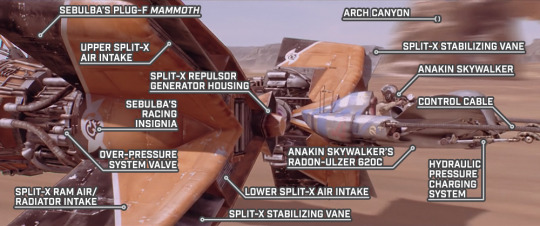
STAR WARS EPISODE I: The Phantom Menace 01:06:54
#Star Wars#Episode I#The Phantom Menace#Tatooine#Boonta Eve Classic#podrace#Arch Canyon#Sebulba's podracer#Plug-F Mammoth#Anakin Skywalker's podracer#Radon-Ulzer 620C#upper Split-X air intake#Split-X repulsor generator housing#Sebulba's racing insignia#over-pressure system valve#Split-X ram air/radiator intake#Split-X stabilizing vane#lower Split-X air intake#Anakin Skywalker#control cable#hydraulic pressure charging system
1 note
·
View note
Text
Performance Automobile Fundamentals: Must-Have Components for each JDM Supporter
Introduction
Every vehicle lover recognizes that the heart of any sort of efficiency car lies in its own parts. For enthusiasts of Japanese Domestic Market (JDM) autos, this bands especially accurate. Along with an abundant record of design superiority, Eastern makers like Honda, Toyota, and also Nissan have developed a number of the absolute most sought-after efficiency vehicles on earth. Whether you're trying to enhance your Civic or even turbocharge your GTR, comprehending the Performance Vehicle Basics: Must-Have Components for Every JDM Fan is vital for getting the most out of your ride.
In this detailed overview, our experts'll discover vital parts and also devices developed specifically for JDM enthusiasts. Our company are going to delve into upgrades that may dramatically strengthen your auto's functionality, dealing with, and also aesthetics while always keeping premium and also cost in thoughts. So bend up as our team take you on an adventure via the must-have components every JDM fan should consider!
Performance Automobile Fundamentals: Must-Have Parts for each JDM Fan
When it https://hdwerks.net/products/r33-gtr-cupholder-nissan-skyline relates to functionality cars, specifically coming from Japan, there are numerous essential components that can easily increase your vehicle's capabilities. These components not merely boost rate yet additionally enhance managing as well as general driving encounter. Let's dive deep right into these essentials.
1. High-Performance Engine Components 1.1 Improving Your Air Intake System
Your motor needs to have sky-- tons of it! An updated sky intake device is just one of the initial modifications numerous JDM fans consider.
Benefits: Increases sky circulation to your motor, enhancing combustion. Options: Cold air intakes or quick ram intakes are wonderful alternatives. 1.2 Exhaust Solutions That Roar
A high-performance exhaust unit is yet another must-have part.
Why Upgrade?: It lowers back tension and also allows exhaust gasolines to exit additional freely. Types: Cat-back units are actually preferred among enthusiasts. 1.3 ECU Tuning for Optimal Performance
Reprogramming your Motor Control Unit (ECU) can discharge low compertition power.
What Performs It Do?: Readjusts energy maps as well as ignition timing for boosted performance. Aftermarket vs. Genuine: Both alternatives exist; select based on your needs. 2. Revocation Upgrades for Enhanced Handling 2.1 Coilovers vs. Lowering Springs
If you prefer much better handling around edges, upgrading your revocation is critical.
Coilovers: Deal modifiable flight elevation and damping settings. Lowering Springs: Provide a much more economical possibility but less adjustability. 2.2 Sway Bars: Supporting Your Ride
Sway clubs decrease physical body roll during the course of stinging turns.

youtube
Benefits: Enhances collaring reliability and also forms steering a lot more enjoyable. 3. Wheels and also Tires: The Ground Connection 3.1 Lightweight Alloy Wheels
Up
0 notes
Text

From top:-
1966 Ford Fairlane 427 R-Code, a rare and powerful muscle car. Unique Features: Solid lifter camshafts, forged crankshaft, medium-riser aluminum intake manifold. Designed for drag racing and was known for its speed and performance. Only 57 (fifty seven) were made and all were originally Wimbledon White with a black interior. These spectral anomalies were built with minimal frills to maximize power. The R-code Fairlane was a street-legal drag racer. Mechanical details ⬇️
2nd from top:-
1967 Shelby GT500 Super Snake. It was originally a Shelby GT500 Mustang modified with a 427 cubic inch racing engine, and was intended to test Goodyear's Thunderbolt tires. It was capable of reaching speeds of around 170 mph.
427 cubic inch (7.0-liter) V8 engine derived from the Ford GT40 racing program. 550 hp (though some sources suggest over 600 hp) with 550 lb-ft. 0-60 mph: Approximately 4.1 seconds and top speed of 170 mph (274 kph). Kelsey-Hayes front disc brakes. Goodyear Thunderbolt tires.
3rd from top:- 1969 Ford Torino 428 Cobra Jet featuring a powerful 428 cu in (7.0 L) V8 engine rated at 370 hp, but some sources suggest it was also closer to 400 hp with optional Ram Air induction. Complete with competition suspension, oil cooler, staggered rear shocks, power front disc brakes, and heavy-duty springs. 0 - 60 mph in 7.7 seconds and quarter-mile in 15.8 seconds at 90 mph.
1968 Ford Torino GT 428 FE V8 Specs :- https://www.hotcars.com/highest-power-ford-torin-engine/#:~:text=Instead%2C%20Ford%20added%20a%20less,GT%20428%20FE%20V8%20Specs
4th from top:- 1969 Ford Mustang Boss 429. Officially rated at 375 hp, but likely closer to 475 hp or more and 450 lb-ft. of torque out of the 429 cu in (7.0 L) V8 with semi-hemispherical heads which Ford called "crescent". The Boss 429 was designed for NASCAR homologation and engine designed with Nascar Heavier Crank Shaft & Connecting Rods. The Mustang's body however was not wide enough to encompass the massive Boss 429 engine and as a result, Ford hired Kar Kraft out of Brighton, MI to modify existing 428 Cobra Jet and Super Cobra Jet Mach 1 Mustangs to properly fit the new Boss 429 engine.
It features a unique hood scoop, a chin spoiler, and optional rear spoiler and louvers. The interior included a top loader Hurst T-handle shifter. Only 859 units made in 1969 and auction prices have reached $1/2 a mil.
https://www.rmw.lv/car/en/mustang-boss-429-s-code-1969#:~:text=The%20cars%20were%20rated%20very,nothing%20has%20been%20actually%20proven.
5th and last:- 1970 Ford Torino Super Cobra with a 429 Super Cobra Jet engine. Difference from 1969 Ford Torino 428 Cobra Jet (3rd from top) engine lies in the engine itself and included features; 4-bolt main block & stronger block for better durability, forged pistons & stronger rods for enhanced performance & longevity, a larger, more aggressive mechanical camshaft for improved breathing & power, 780 CFM Carb: A larger 780 cfm Holley carburetor, header-style exhaust manifolds, an external oil cooler for better cooling & reliability & a Ram Air system for increased airflow and power & all these aided output in excess horsepower 425 (unofficially). To improve oomph, Super Cobra Jet often came with the optional Drag Pack, which included a stronger rear axle with higher gear ratios (like 3.91 or 4.30) and only 241 built with these specs.
youtube
#ford#ford racing#ford torino#ford mustang#ford cobra 🐍#police interceptor#cobra jet#ford fairlane#boss 429#nascar#racetrack#raceway#raceready#american exceptionalism#exquisitely#extremely#Youtube
9 notes
·
View notes
Text
Get the best Away From Your Motor along with These Functionality Components
Introduction
When it pertains to enriching the performance of your car, buying top notch efficiency parts is necessary. Whether you are actually a veteran racer or even a weekend warrior keen on boosting your ride, comprehending just how to obtain one of the most away from your engine can substantially impact your total steering adventure. This post will definitely check out several efficiency upgrades and extras that can aid you open your motor's capacity, concentrating on preferred Japanese companies like Honda and also Toyota, as well as iconic models like the Nissan GTR as well as Civic.
So clasp up, given that our company are about to dive deep right into the globe of auto efficiency parts!
Get the Most Out of Your Engine with These Efficiency Parts
Getting one of the most away from your motor involves deciding on the right performance components that straighten along with your certain targets. Whether you are actually pursuing improved hp, far better fuel performance, or strengthened handling, there is actually a myriad of alternatives accessible to match every need.

Understanding Motor Performance What Establishes Engine Performance?
Engine performance is figured out next to many aspects, including:
Airflow: The amount of sky going into as well as exiting the engine directly impacts its own energy output. Fuel Quality: High-octane energy can enhance ignition efficiency. Tuning: Appropriate tuning makes sure that all parts work harmoniously. Aftermarket Upgrades: Including efficiency components may greatly improve total effectiveness. Why Think about Efficiency Parts?
Performance components are designed to optimize different aspects of your motor vehicle. Whether it is actually raising hp or boosting torque shipping, these upgrades yield positive advantages. Coming from turbochargers to tire bodies, aftermarket possibilities supply innovative options for everyday motorists as well as nationality lovers alike.
Types of Functionality Parts Engine Swaps What is a Motor Swap?
An engine swap includes replacing a vehicle's original engine with another one-- frequently coming from an even more powerful style. As an example, swapping a Civic's supply engine for a K-series motor opens up doors to much higher horsepower levels.
Benefits of Motor Swaps Increased electrical power output Enhanced reliability Greater customization options Intake Systems Why Upgrade Your Consumption System?
A high-performance consumption device boosts air flow right into the motor. This causes more oxygen being combined with energy, allowing far better combustion.
Types of Consumption Systems Cold Air Intakes Short Ram Intakes Ram Air Intakes How Performs a Consumption Body Work?
An improved consumption unit draws cooler sky coming from outside the engine bay instead of warmer sky outward it. Cooler air is actually denser and has more oxygen molecules-- vital for making best use of combustion efficiency.
youtube
hdwerks R33 GTR Cupholder Exhaust Systems The Part of Exhaust Equipments in Performan
0 notes
Text
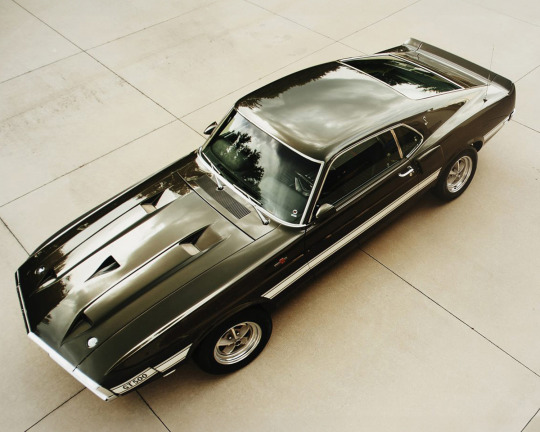
1969 Shelby Mustang GT500 Fastback
1969 was, effectively, the final year for the Shelby Mustang. By now assembly had shifted in Michigan from California where it was contracted out to A.O. Smith Corporation. Smith, an established Motor City contractor, had brought a level of serious manufacturing skill, supplier management, procedure and standards never seen at Shelby’s facility where LAX met the vibrant (and sometimes extreme) subculture of Venice, California.
Now largely designed and specified by Ford staffers, the 1969 Shelby Mustang was drastically different visually from the standard Mustangs, with a completely different nose and grille, a wide rectangular opening with blacked out grille flanked by 7” headlights and with Shelby’s characteristic driving lights now smaller rectangular pieces below the attractive, but largely ineffective, bumper. The special Shelby hood had five ducts, three NACA-style surface ducts replaced the complicated but entertaining shaker hoods of years gone by to supply cold air directly to the engine air intake and two extractors at the back of the hood relieving underhood pressure and exhausting heated air in front of the windshield.
A surface duct behind the headlights and a scoop behind the door and in front of the rear wheel arch that was ducted to the rear brakes continued the performance theme. The rear panel was completely different from the Mustang, housing a set of 1965 Thunderbird sequential taillights with the rear license plate placed between them and including a small ducktail spoiler. The area under the bumper where standard Mustangs carried their license plate contained two rectangular outlets for the Shelby’s dual exhaust system. Standard wheels were unique 5-spoke Mag Stars with alloy centers and chrome steel rims.
Under the hood lay the 428 Cobra Jet which had powered the ’68 Shelby GT500KR. Both Ford and Shelby recognized the superiority of the high performance CJ and made it the standard engine for 1969’s Shelby Mustangs.
At the end of the 1969 model year 789 Shelby Mustangs were in-process at A.O. Smith. They were visually updated with black hood stripes and a chin spoiler and given new VINs. Otherwise the 1970s were exactly the same as the ‘69s making these two years essentially identical examples of the end of the Shelby Mustang series which had begun only a scant six years before.
Avidly sought by collectors and obsessively documented by the Shelby American Automobile Club, most Shelby Mustangs are well known and have well known histories. Occasionally, however, a example appears which has been out of sight for years. Even more rarely it turns out to have been little used and continuously maintained by a thoughtful and caring single owner for nearly forty years.
The Black Jade 1969 Shelby Mustang GT500 Sportsroof fastback offered here is one of those rare and highly desirable cars. It was delivered new to Ford’s dealer in Yokohama, Japan, Marubeni Motors K.K., and was sold thereafter to its first, and only, owner in Japan. It has been repainted in the original color once but is otherwise completely original, as delivered and has only 84,941km on its metric-calibrated export speedometer (52,779 miles.) Its sympathetic maintenance and care shows throughout in its clean, straight, rust-free condition.
Power of course comes from the 428 cubic inch Cobra Jet Ram Air V-8 engine which Ford and Shelby conservatively rated at 335 horsepower at 5,200rpm and a gut-wrenching 440 lb-ft torque at 3,400rpm. It puts the power through Ford’s highly regarded C-6 automatic transmission and Traction-Lok differential with high speed 3.00:1 gearing that takes full advantage of the CJ engine’s torque. In addition to the highly desirable drivetrain specification it is loaded with options including the Visibility Group, Goodyear white letter tires, Sport Deck folding rear seat, power front disc brakes, power steering, tilt steering column, Selectaire air conditioning, AM/8-track stereo radio, tinted glass, deluxe belts, tachometer and trip odometer.
It is finished in one of the Shelby Mustang’s most attractive colors, Black Jade. The interior and high back buckets seats are upholstered in black Clarion Knit/Corinthian vinyl that complements with Black Jade exterior.
It returned to the U.S. in 2006 but has never been titled by its current owner so it remains a one-owner car. Its absolutely clear history, one-owner provenance, highly original condition with known mileage and extensive options list are attributes shared by few Shelby Mustangs of this age. This is a rare opportunity for an astute collector to acquire a particularly significant, unmolested Shelby Mustang from the last, and most highly developed, series.
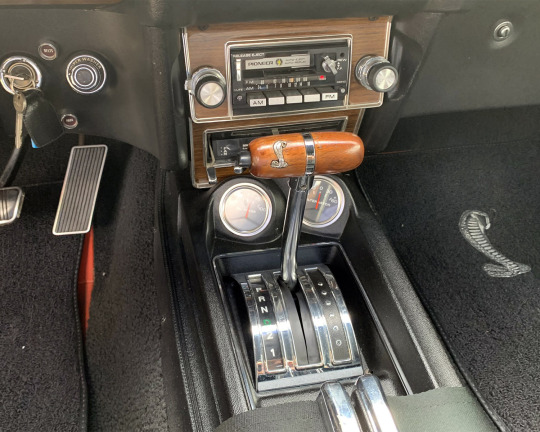
1969 Shelby Mustang GT500 Fastback
Powered by a 428ci V8 engine mated to a C6 automatic transmission, this beauty includes the original #Shelby owner card, a copy of the Shelby work order and Window Sticker.
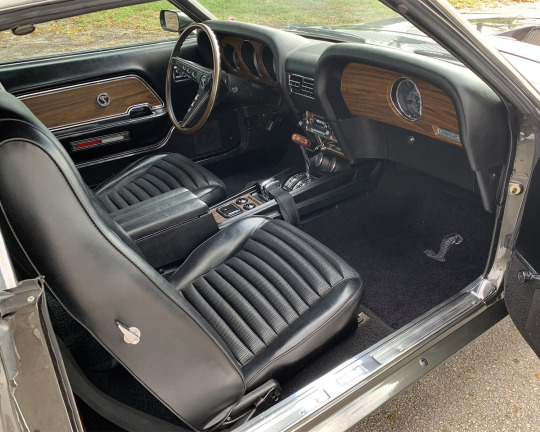
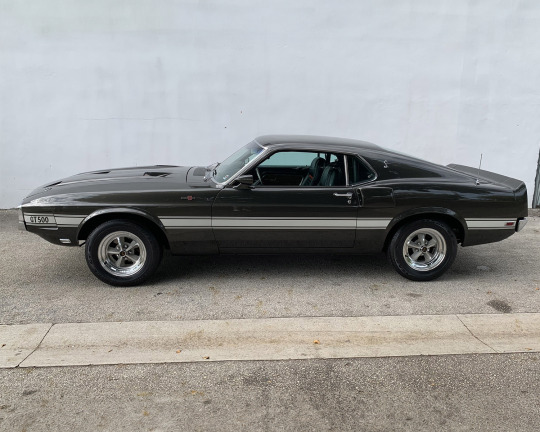

1969 Shelby Mustang GT500 Fastback

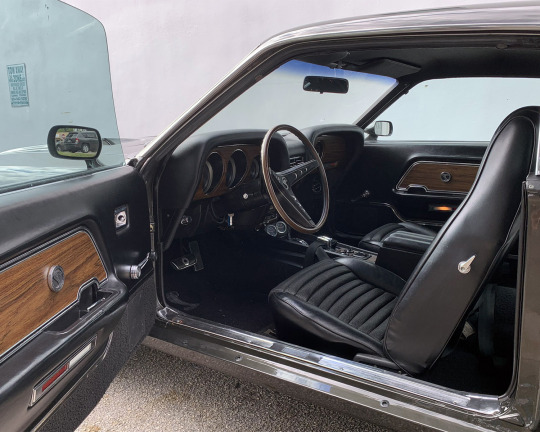
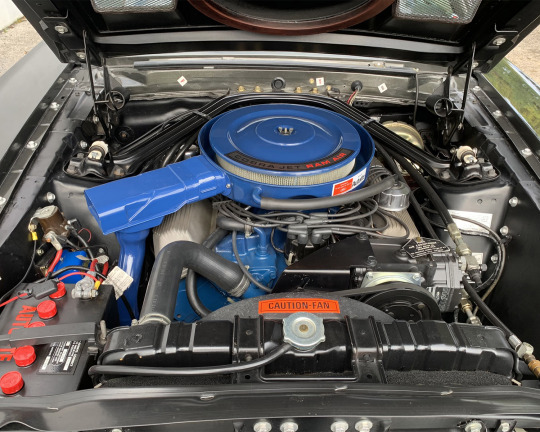
1969 Shelby Mustang GT500 Fastback
#Shelby Mustang GT500 Fastback#Shelby Mustang GT500#Shelby Mustang#Mustang#Shelby#car#cars#muscle car#american muscle#ford
125 notes
·
View notes